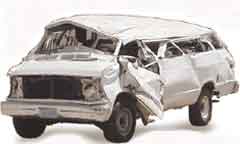They account for a small share of crash deaths, but passenger vans can be risky Fifteen-passenger vans are intended to transport up to, well, 15 people. But there’s a safety downside - as the occupants pile in, the risk of rolling over goes up. Most rollovers involve one vehicle, and single-vehicle rollover crash risk actually is lower for lone drivers of 15-passenger vans than for drivers traveling alone in SUVs. But a government analysis indicates that adding more people to either kind of vehicle raises the risk of rolling over by about 9 to 12 percent per person - and vans hold more people.

“So the fact of high occupancy is the problem. The purpose of the vans also is the source of their risk,” says Susan Ferguson, the Institute’s senior vice president for research.
A 2001 report conducted for the National Highway Traffic Safety Administration (NHTSA) associates the increased rollover risk of 15- passenger vans with their centers of gravity. A high center of gravity means a higher risk of rolling over, and a 15-passenger van’s center of gravity rises about 4 inches as the vehicle is fully loaded. This compares with 1.4 inches for a fully loaded 7-passenger van and 0.9 inch for a minivan. NHTSA says the 4-inch difference translates into a 40 percent increase in the propensity to roll over.
Another NHTSA report compares the odds of rollover when a vehicle is fully loaded versus a driver only. This ratio is 1.2 for cars, 1.5 for pickups, about 2 for SUVs and minivans, and 5 for 15-passenger vans. Given these comparisons, it’s not surprising that a greater proportion of deaths in single-vehicle crashes of vans occurs in rollovers. During 2000-04 the proportion of all occupant deaths in singlevehicle crashes that occurred in rollovers was 83 percent for the vans compared with 76 percent for SUVs, 60 percent for pickups, 58 percent for minivans, and 45 percent for cars.
To reduce the risk of rolling over, most new 15-passenger vans are being equipped with electronic stability control (ESC) - important because NHTSA tests show that drivers of big vans with ESC are less likely to lose control of their vehicles in the kinds of high-speed maneuvers that can result in rollovers. Studies of the real-world experience of vehicles with and without ESC also demonstrate the benefits of this technology in reducing single-vehicle rollovers (see Status Report, Jan. 3, 2005; on the web at www.iihs.org).
Last year NHTSA began publishing the results of handling tests conducted to rate the stability of some passenger vehicles (see Status Report, March 6, 2004; on the web at www.iihs.org). Now Congress has told the agency to begin conducting the same tests to rate 15-passenger van stability.
Maintenance is another issue, and tire pressure might be affecting van stability. According to a NHTSA study released earlier 15-passenger vans have at least one substantially underinflated tire. This compares with about 30 percent for cars, SUVs, and pickups. About 1 in 4 vans has an overinflated tire.
And what about the van drivers? Some of them might not operate such big vehicles on a regular basis. They might be unfamiliar with the way 15-passenger vans handle and the extra risks when fully loaded. Yet the drivers don’t have to undergo any special training. Commercial licenses are required to drive vans with room for 16 or more people but not for this year, more than half of all vans designed for 15. States may impose their own restrictions if vans are used commercially, but no special license is needed for mom or dad, for example, to transport a sports team or church group.
Extending commercial licensing requirements to 15-passenger van drivers might sound like a good idea, but there are unknowns. If the result were that fewer groups traveled by van because of a shortage of licensed drivers, the occupants might spread out into multiple vehicles. The safety consequences of putting more vehicles on the road to transport the same number of people are unknown.
This is worth thinking about because, despite their stability problems and high proportion of deaths in rollover crashes, 15-passenger vans don’t have alarmingly high overall death rates. Driver deaths per million registered vans during 2000- 04 numbered 57. This compares with an average of 108 for all passenger vehicles (cars, pickups, SUVs, and vans).
The death rate for all occupants, not just drivers, was higher in the vans than in the other kinds of passenger vehicles - 231 per million versus an average of 156 - but this is largely attributable to the the vans’ higher occupancy. When big vans crash, more people risk dying.
The usual safety measures like buckling up can reduce these deaths. Fifteenpassenger vans have belt systems at every seat, but only about 20 percent of people killed in van crashes during 2000- 04 were using their belts. More than half of the fatally injured occupants without belts were ejected from the vehicles. “The perspective we need to keep is
that 15-passenger vans aren’t menaces on the road. They aren’t accounting for a big proportion of motor vehicle deaths. But when they’re loaded they do pose a risk to their occupants. This problem should lessen in newer vans equipped with ESC, but still we need to pay attention to who’s driving the vans, how they’re maintained, and whether their occupants are doing what all vehicle occupants should do, like buckle up,” Ferguson concludes.




